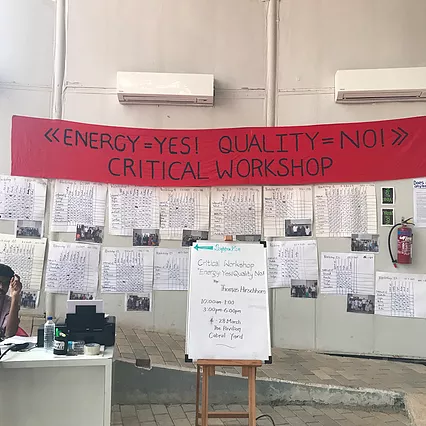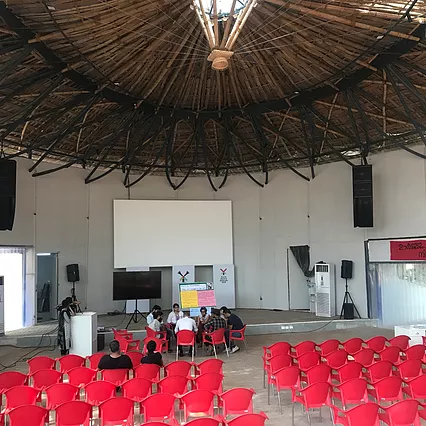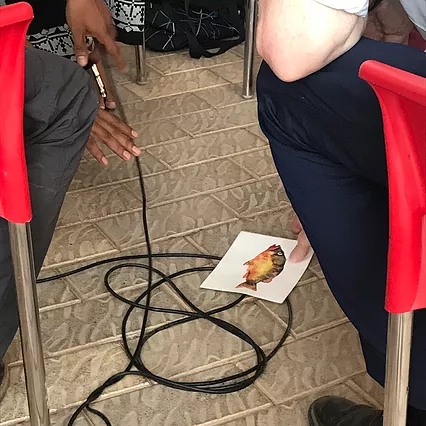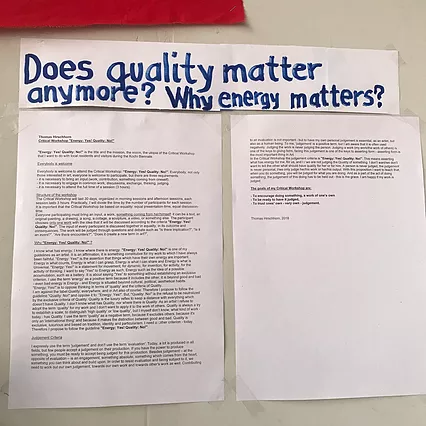Thomas Hirschhorn @ Kochi Biennial
GDLP
Emoji summary: 🎁💬😌
WELLLLLL WELL WELL, I FINALLY WENT TO A WORKSHOP I thought was GOOD slash mildly revolutionary. All you workshop stans can shut up now. When I went to Kochi Biennale a few weeks ago i went to a ‘critical workshop’ by Thomas Hirschhorn and ngl i’m mad because i’ve spent 3 years trying to be a critic that speaks about art in the opposite way to old white men, and ironically what i’ve found here is an old white man doing me but with better posture and a fairer way of speaking. i cannot cope ! i AM THROWING THE HAT IN. lemme haphazardly explain.
During the last few weeks of the biennale, Hirschhorn’s free workshop ‘Energy: Yes! Quality: No!’ invited people to bring something along they’d made to be judged, carefully. and it could b anythin - a film, a song, whatever. Someone I know was going to take a chair they’d painted for example. The participants sat together with the artist on red plastic chairs arranged in a circle and he began by telling them what energy and quality meant to him, those being the two key words in the title of this rolling event. He explained that quality was like, the thing art in museums inherently has because it’s been given an importance by cultural gatekeepers: u kno, the curators, collectors, critics, art historians, and even the market, all colluding for it to be there. But Hirschhorn explained that there’s a problem in how we connect with the art there based on its level of quality alone, because quality is always about exclusion. It’s about what’s not in the museum. this is in but that one’s out. He proposed that instead of talking about art in terms of just quality, we think about its ‘energy’ instead, because energy is ‘much more unstable and open.’ And the way he saw it was like - every thing in a museum has quality but for you it might not have energy, like you might not connect with it. Art made by you in your bedroom might not have quality because it hasn’t been validated by the powers that be, but it could hold great energy to someone - it could make them cry or laugh, it could ~move~ them. In his own words (i was taking notes as if I know shorthand), he prefers ‘energy’ because ‘I believe something we are the author of has an energy, or should have an energy I hope. Then I can relate, I can make contact to it, because there’s an energy of some love, pain, sadness, something somebody put in and I can catch it. I must get the energy. Without - and this is very important - without knowing already the context, all the information, all the excuses of why is it like this and not like this. If I go to the Biennale there is a lot of artworks, I’m not going there to read all the texts. I want to be touched, involved, implicated with the artwork directly. And sometimes I got it because I could feel the energy and sometimes not.’ SAME thomas, SAME. you go to a new city and go to the big museum there and sometimes feel nothing at all. people are crowded around the mona lisa but when you stand in front of it does it even make you feel? does it even have an energy, or is it just exciting because there’s lots of people in the room acting excited? I’ve felt guilty for not being moved by important artworks before, and felt fucking quirky for supporting cool things by people who don’t have a name. this workshop just settled the tensions for me, had everyone reveal their cards.
So with these new meanings for energy and quality in the room, participants holding one in each hand, the group were invited to judge the art they had brought with them into the circle. The person that went first played a short film and once it was finished, everyone took their turn saying whether or not they thought it had energy: literally one by one, ‘yes, yes, no, yes, no, yes.’ everyone then had to explain why they’d said what they’d said, telling us about that small physical experience between you and the art, the beginning and end of that moment; where it took you, how it was informed by all the things you have known before. and this is like ! ! another simple effect of the whole process and language around Hirschhorn’s critical workshop that no one was talking about the person that made the thing, they were simply judging The Thing. Critique, in this semi casual setting, was not seen as a personal attack but instead as a stranger offering their own singular experience of the art before them. How it made them feel, what it reminded them off / why it didn’t make them feel anything or why it might have rubbed them the wrong way. When I was an art student this was the norm, but since i’ve left and started writing about art on this website and across instagram and twitter, it’s all too often i see people freak out that a negative comment means the maker themselves is less-than. it was never about them to begin with, and how dare they make it so tbh. It was also normal in this workshop to say yes and to have your neighbour say no, there was no expectation for a consensus and often no neat agreement in the air. Like, the second item up for judgement was a watercolour of a fish on a white background, and one person said Energy Yes because it reminded them of an idiom their nan used to say in Malayalam about how even a dead fish looks nice (so you should always make an effort to look good). The next participant said Energy No because they didn’t like that it looked like a diagram in a biology textbook, a dead fish on a white contextless background. I think there’s a pressure sometimes when criticism takes place in a collective space ie. the internet to like and agree with your followers or following over content, meaning less respect for nuance and difference in opinion over such harmless things. Like, a fish’s a fish, it’s not the end of the world if you’re not living for it.
there are a few reason going to a crit can help make your work better imo, reasons I think are worth mentioning here. Firstly, It’s good knowing what randomers think of your work incase it’s doing something wildly different than what you had hoped for, and feedback can help you get it closer. Also, crits are a good stress test. For example, if the five people there are saying ‘I wish you had used the colour blue instead of red’ because they all just prefer blue, you at least know how important the colour red is to you if you’re putting your foot down and telling them no. You’ve tested it and you know it’s got to stay. There was a point at the beginning of the whole workshop where Hirschhorn said he’s not afraid of judgement. He said to the group, ‘You are all authors, you brought something you did. It makes you proud but it gives you responsibility. You must accept the responsibility that somebody wants to judge it. If we’re doing something, we must be proud enough to let them judge it.’ i appreciate that, i need to keep it in mind tbh.
And so, with Hirschhorn’s framing, judgement was healthy (again), nothing was personal (again), and everyone was invited to chat about art through their own lens. personally, I needed this recalibration. Did your teacher ever recalibrate a smart board? touching smart board pen to the cross at each corner so it knew exactly where it was again, physically and mentally in the world. if you can’t remember or u are not the very specific age that smart boards were about, you can have another analogy; it was like cracking your back and feeling right in those bones again. lying on the floor, bringing a knee to your chest and pulling it over to the opposite side of your body, twisting til you hear pop, pop, ahhh. I’ve been telling everyone about this reset approach to art since I went to india - the way white people go to india to find themselves through yoga retreats on the beach, i can’t believe I basically fucking did the exact same thing except it was for art criticism. But these are the things that are important to me - how we talk about art, who feels like they have the right to discuss a painting, and giving people the tools to do so. Like, I wrote the text last year ‘why I don’t read the press release’ basically trying to justify why I want my energy to come from art and not the wall text doing the explaining - if I wanted that, i’d just read an essay. I’m in the gallery because arts the thing that goes beyond written language and I wanna see that happen. Ahhhhh. I’m just so glad I went to this !!! The White Pube has been a long exercise in embodied criticism and trying to write about art through owning your own experience in the gallery. i’ve always used the words ‘aesthetic experience’ when ‘energy’ is so much more legible. and that legibility is more and more political to me the longer I spend in the art world, where i’m suspish people are barricading themselves into the art world with theory and bad language to keep everyone without an art degree outta here. So ya catch me walking round exhibitions now pointing at things saying ‘energy yes, energy no’ like i am finally on a level playing field with the institution because i know which words to use. energy, quality. i go between them justifying and reasoning ambivalence and movement, like this physical wave between my feelings.



